CSUN Biology Prof Paves Way for Future Breast Cancer Treatments
Imagine breast cancer as cells hidden in an invisible house — a house whose blueprints researchers have been hunting for decades. Now imagine suddenly discovering a key support wall for this house, a support wall that could change the future for breast cancer treatment.
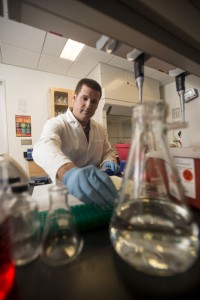
CSUN biology professor Jonathan Kelber makes cancer cell samples to analyze in his lab. Photo by Lee Choo.
California State University, Northridge biology professor Jonathan Kelber and a team of nine students are leading the pack in breast cancer research by identifying a critical cancer “support wall” gene called PEAK1. The results of their research have been published in the Public Library of Science (PLoS) One journal, titled “PEAK1 Acts as a Molecular Switch to Regulate Context-Dependent TGFβ Responses in Breast Cancer.”
The report is the first ever to show that the PEAK1 gene is essential at the earliest stages of aggressive breast cancer metastasis. Metastasis is the process of cancer cells moving from its original source – in this case the breasts – to other parts of the body through the blood stream and forming malignant tumors elsewhere.
“There is a huge question in cancer research about the role of TGFβ [which is a protein that regulates cell growth],” Kelber said. “The big problem is that TGFβ normally suppresses tumor growth, but in some cases, it actually promotes tumor progression.”
In healthy human cells, the TGFβ protein keeps cell growth and placement under control. But, in some forms of breast cancer, the presence of TGFβ induces a process called epithelial-mesenchymal transition (EMT). EMT causes benign epithelial — harmless tightly packed — tumor cells to transform into malignant mesenchymal — bad loosely packed — cells at an accelerated rate.
To date, complete understanding of the mechanism for how this switch occurs is still being sought, but Kelber said that because he and his team identified a central role for PEAK1 in this process, their discovery could help researchers understand breast cancer metastasis better.
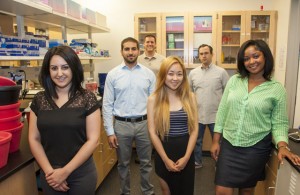
Left to right, CSUN graduate biology students Yvess Adamanian, Armen Gharibi, biology professor Jonathan Kelber, undergraduate and MARC scholar Sa La Kim, graduate students Justin Molnar and Malachaia Hoover stand in one of the cancer research labs at CSUN. Photo by Luis Garcia.
“The whole process of metastasis is what leads to patient mortality,” Kelber said. “It’s aggressive and you don’t know where it goes. It could show up in the brain, the bones, or the liver for example. If you can block the process of metastasis, or figure out how to slow the growth of cells once they have metastasized, that is of great value.”
Megan Agajanian, who received her master’s degree in biology from CSUN in May and will begin her doctoral work at University of North Carolina, Chapel Hill this fall, is the primary author of the study. She explained that while the entire picture of why breast cancer occurs is not known, discovering the PEAK1 “wall” is a major breakthrough.
“If you don’t have one of your walls, which is PEAK1, then you’re not going to be able to build the [cancer] house,” she said. “It’s kind of hard to say who starts building the house, at this point really, a lot more studies need to be done.”
Kelber noted that since PEAK1 is now identified as part of the tumor growth acceleration machinery in breast cancer cells, patients who show high levels of the gene could be considered good candidates for different cancer treatments.
“[PEAK1 over-production] could indicate patients that have a poor prognosis and are better candidates for certain therapies that block the bad TGFβ effects,” Kelber said.
Agajanian and Kelber collaborated on a different article published in Biochemical and Biophysical Research Communications (BBRC), titled “Identification of a PEAK1/ZEB1 signaling axis during TGFβ /fibronectin-induced EMT in breast cancer.” That research identified specific breast cancer cells that are sensitive to high levels of PEAK1, such as triple negative breast cancer. Their article says that while triple negative breast cancer is the most rare subset of breast cancer, it is “the most aggressive and difficult to treat due to the lack of validated therapeutic targets.”
“Basically there are no molecular markers in [triple negative breast cancer],” he said. “You can’t target it. But… PEAK1 is a possible target and maybe a biomarker telling us which patients would be good candidates for anti- TGFβ treatment. It could be a viable target, which, until today, we didn’t have.”
Kelber did research and received his undergraduate degree from Cal Poly Pomona before completing doctoral and post-doctoral training at the Salk Institute and the University of California, San Diego. Because he had exposure to hands-on lab work as an undergraduate, he said he was inspired to continue doing research and include students at CSUN.
“I’m familiar with the many strengths of the CSU system. That’s one of the reasons I was attracted to CSUN,” Kelber said. “I think getting students in the lab doing research, taking ownership of their scholarship early on and making an impression is valuable to their futures.”
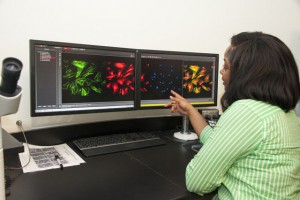
CSUN RISE scholar and biology graduate student Malachaia Hoover discusses the cell samples she analyzed. Photo by Luis Garcia.
Kelber’s research team consists of four undergraduate and five graduate students, including Malachaia Hoover. Hoover began as a Louis Stokes Alliance for Minority Participation undergraduate researcher in Kelber’s lab since its beginnings in Fall 2012. She also was a co-author on the article featured in PLoS One and began her graduate research at CSUN in 2014 as a Research Internship in Science and Engineering scholar.
“This is what I like to do. [Studying human disease] is my passion, and research strengthened my passion for it,” Hoover said.
Yvess Adamanian, a graduate student who has worked in Kelber’s lab since 2012, said ever since she began researching as an undergraduate, her greatest passion is aiming to understand why cancer happens.
“All of this was voluntary work,” she said. “I put aside some hours everyday and was able to accomplish a lot as an undergrad. I can’t wait to see what my master’s thesis will uncover.”
Kelber said research at any level is an important step in expanding students’ experience.
“It doesn’t matter what you are doing topic-wise, but doing research [as a student] is important,” he said. “I had an outstanding undergraduate research experience at [Pomona], and that is what turned me on to CSUN. It is a great goal from the top down to gain more funding for research. There is a lot of interesting and important research being done at CSUN, all of great value to its own niche.”
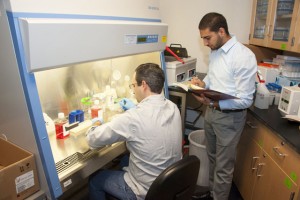
Left to right, CSUN graduate students Justin Molnar and Armen Gharibi take notes and analyze cell samples in the lab. Photo by Luis Garcia.
But most importantly, the research conducted at CSUN can change the future, as Kelber and his team noted.
“I have friends that have battled cancer. It’s definitely a real thing. We’re not just playing science,” Kelber said. “We’re making progress, and there is so much more work to be done. There are people all over the world working on these problems. It’s nice that we are able to make differences here at CSUN.”

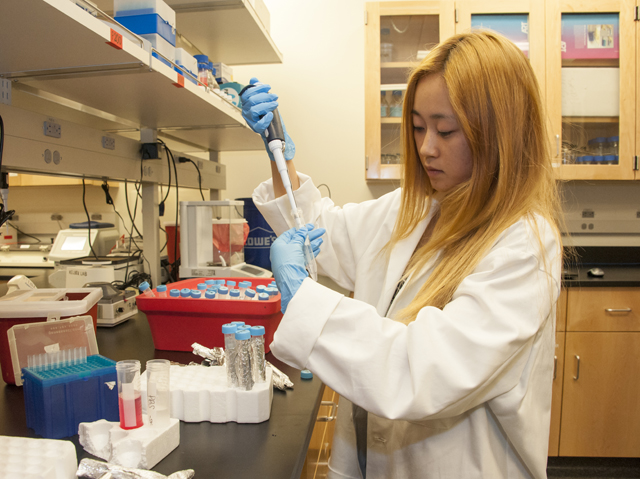
 experience
experience